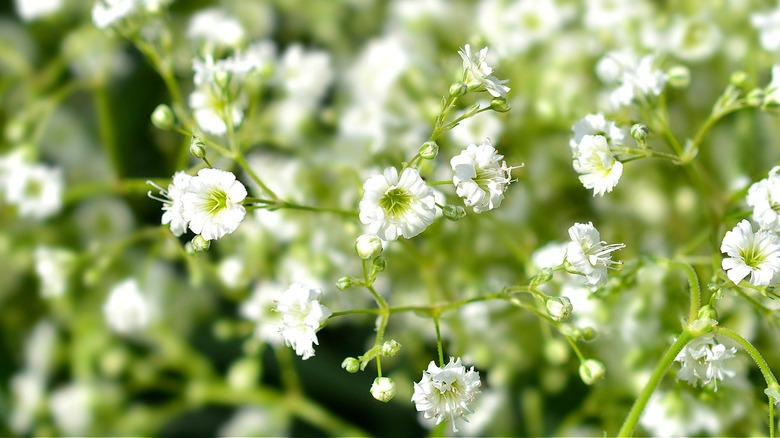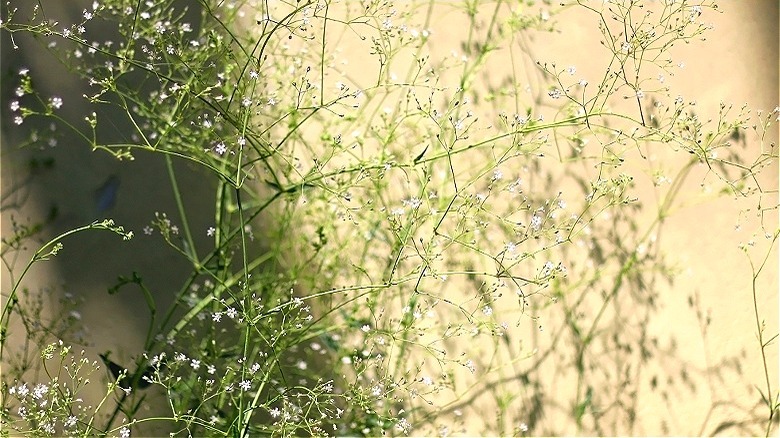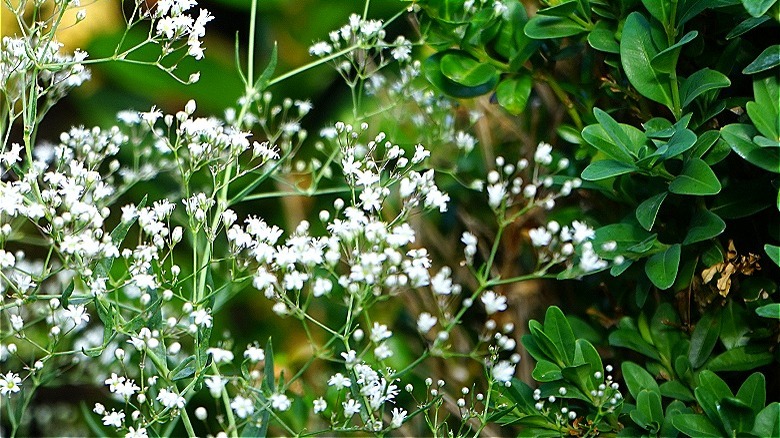Why You May Want To Think Twice Before Adding Baby's Breath To Your Garden
Historically used as a filler in bouquets, as well as for boutonnieres, baby's breath has moved from the wings to center stage in recent years. Hoping to feature the cloudlike, ethereal blooms in their own homes, gardeners today are not only looking into how to grow and take care of baby's breath but design with the delicate flora, too. There's no shame in jumping on the baby's breath bandwagon, especially if you dream of complementing your busy living spaces with sprays of the understated white flowers. However, before you plant baby's breath in your garden, you may want to think twice, given the plant's propensity to become invasive in some areas due to its ability to produce millions of seeds.
Baby's breath, also known by its scientific name, Gypsophila paniculata, hails from the Caryophyllaceae family. Its soft blooms, which mimic tiny carnations, not only make baby's breath a desirable addition to a cut flower garden, but it can also add balance to a yard with hard edges. The contrast between the fluffy blossoms and a retaining wall or borders of sharp-cornered hedges creates a harmonious vision envied by the entire neighborhood.
Yet, looks can be deceiving. Baby's breath may appear to be a sweet, gentle plant but underneath all that white plushy cover looms an extensive taproot that's painstaking to remove once it's established. What's more, given its prolific reproduction powers, baby's breath has the ability to overcome native plants and hijack their habitat.
Identifying the invasive qualities of baby's breath
Inviting yet invasive. It's the double-edged sword dilemma plaguing countless home gardeners looking to plant baby's breath on their property. If you're still in limbo, consider this sobering fact: Baby's breath is listed as a noxious weed in California and Washington because it's so difficult to control. According to the Washington State Noxious Weed Control Board, a single baby's breath plant averages 13,700 seeds, which can spread easily in the wind and traverse great distances. Meaning, a single baby's breath plant growing next to your mailbox has the potential to carpet an entire neighborhood with airy blooms.
In Michigan, this rapid proliferation has threatened the state's legendary sand dunes by suffocating native plants. While the problem hasn't led Michigan to issue an outright ban on homeowners growing baby's breath, the Northwest Michigan Invasive Species Network has documented the plant's obstruction of various native species, including wormwood, broomrape, and pitcher's thistle (per the Detroit Free Press).
Baby's breath's long and robust taproot, which at full maturation, can extend several feet into the ground, is an invasive characteristic on its own. However, the problem multiplies when the plant is exposed to sandy soil and full sun. This hospitable combination nourishes and subsequently anchors the plant's entire root system, resulting in robust blossoming. However, even when the flowering season has ended, a dome-shaped branch cluster can easily snap off, make like a tumbleweed, and continue to spread seeds with help from the wind.
How to prevent baby's breath from becoming invasive
As a responsible homeowner, it's your duty to consider the possible ramifications of baby's breath's rapid proliferation if you plan to add the plant to your yard. This is not to discourage you from enjoying the beauty of baby's breath from your kitchen window; rather, it simply encourages sound gardening. After all, there's a safe way to cultivate baby's breath without threatening other species.
One option is to place fine mesh insect netting over your baby's breath plants to prevent the seeds from spreading uncontrollably. If you have the space, an alternative would be to grow baby's breath in a shielded structure, such as a greenhouse, covered hoop house, or a cold frame with a transparent roof. However, to ensure the health and well-being of your baby's breath, the latter would need to be positioned in an area that allows for full sun exposure as the plant needs light to thrive.
In addition, given the tenacity of its taproot, if you plan to manage baby's breath, it's best to do so early on when the root system is smaller and not so deeply entrenched in the soil. Likewise, when the plant is younger, it's easier to pull by hand. If your plant is older and your goal is to decrease regeneration, you'll have to cut below the crown to do so. Otherwise, consider suppressing the growth of mature plants and decreasing seedling establishment by exercising heavy and continuous grazing.


